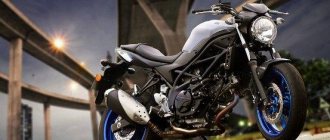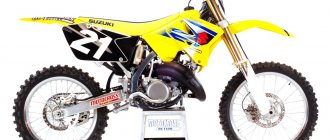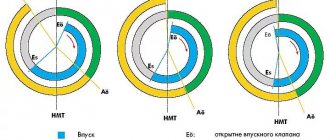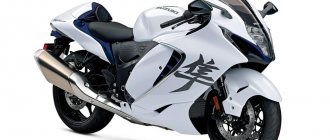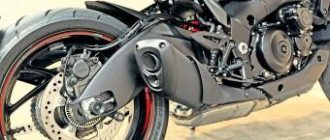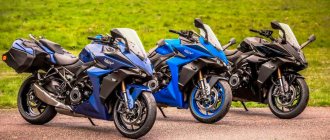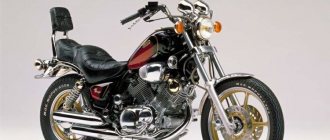EsVe - cafe style!
Suzuki is expanding its SV650 road bike lineup with the addition of the SV650X ABS for the 2022 model year. The “X” includes a few minor body changes, plus a new bullet-shaped front fairing that ties the design back to the 1970s era. The suspension system has been updated across the SV650 range, with spring preload adjustable for the forks. The engine of the new product is a common 645 cc V-twin for the entire line with 75 horses and a number of electronic gadgets to control this herd. What else does Suzuki have in store for us? Let's get a look.
Suzuki sv650x. Cafe racer
Suzuki sv650x. Cafe racer
Suzuki has managed to make a more authentic café racer than many by simply adding a proper fairing to the street bike. Of course, the clip-ons here are non-canonical, but inverted clip-ons are not installed by labor-café workers on production motorcycles for safety reasons, and besides, they will rest against the tank. The result is still achieved: the aggressive riding position clearly characterizes the nature of the 650X. Regarding this nature, Suzuki UK marketing manager Rob Cooper said:
The SV650 is an extremely popular device in the mid-sized segment of the market, and has been so since its launch in 1999. Thanks to its spunky and powerful V-twin and versatile chassis, it combines fun, fast driving with affordability and practicality. Built on this time-tested platform, the SV650X will add retro style to the lineup. Its clip-ons not only work for looks, but also create a sportier riding feel. The spring preload fork will improve ride quality by allowing the suspension to be adjusted to suit riding style and personal preference, and will be available across the 2022 SV lineup.
Naked fans needn't worry: the partial bonnet, a style that harkens back to '70s racing cars, adds only a small amount of weight by about 2kg, so the new SV won't be a plastic sportsbike. The round headlight adds a retro flavor to the motorcycle's styling, as does the blackening of some of the parts, which harkens back to the custom culture where cafe racers originated. Behind the 14-litre tank, the puffy seat creates a shallow recess for the driver and quickly tapers into a sharp tail above the raised subframe. The rear brake light is built into the tail, and the turn signals are built into the license plate holder; all the lights here are diode, providing maximum visibility and safety. The instrument panel is almost entirely digital, with just a couple of indicator lights complementing the LCD display. The display backlight is adjustable to suit the lighting conditions, and it seems that the manufacturer has done a good job, as all important parameters are visible in all situations.
Brief history of the model
1999 - start of production and sales of Suzuki SV650 and Suzuki SV650S. First generation. Model: Suzuki SV650; Suzuki SV650S (Europe, North America, Australia). Factory designation: SV650X, SV650US; SV650SX, SV650SUX.
2000 - no significant changes. Model: Suzuki SV650; Suzuki SV650S (Europe, North America, Australia). Factory designation: SV650Y, SV650UY; SV650SY, SV650SUY.
2001 - no significant changes. Model: Suzuki SV650; Suzuki SV650S (Europe, North America, Australia). Factory designation: SV650K1, SV650UK1; SV650SK1, SV650SUK1.
2002 - no significant changes. Model: Suzuki SV650; Suzuki SV650S (Europe, North America, Australia). Factory designation: SV650K2, SV650UK2; SV650SK2, SV650SUK2.
2003 - restyling of the model. Second generation. Suzuki SV650 and SV650S models receive updated exterior styling, a new instrument panel, cast aluminum frame (instead of tubular), fuel injector, 17L fuel tank (instead of 16L), retuned suspensions and front fork preload adjustment. Model: Suzuki SV650; Suzuki SV650S (Europe, North America, Australia). Factory designation: SV650K3, SV650UK3; SV650SK3, SV650SUK3.
2004 - The model receives a new subframe and a narrower front seat. The rear fender gets a more advanced design and better protects the rear of the motorcycle from dirt. Model: Suzuki SV650; Suzuki SV650S (Europe, North America, Australia). Factory designation: SV650K4, SV650UK4; SV650SK4, SV650SUK4.
2005 - Starting this year, models feature a matte black frame and a smaller radiator. Model: Suzuki SV650; Suzuki SV650S (Europe, North America, Australia). Factory designation: SV650K5, SV650UK5; SV650SK5, SV650SUK5.
2006 - no significant changes. Model: Suzuki SV650; Suzuki SV650S (Europe, North America, Australia). Factory designation: SV650K6, SV650UK6; SV650SK6, SV650SUK6.
2007 - modifications with ABS appear, all models are equipped with 2 spark plugs per cylinder. Model: Suzuki SV650 + ABS; Suzuki SV650S + ABS (Europe, North America, Australia). Factory designation: SV650K7, SV650AK7, SV650UK7, SV650UAK7; SV650SK7, SV650SAK7, SV650SUK7, SV650SUAK7.
2008 - appearance of a modification with a full plastic body kit - Suzuki SV650SF (Sport). Model: Suzuki SV650 + ABS; Suzuki SV650S + ABS; Suzuki SV650SF (Sport) (Europe, North America, Australia). Factory designation: SV650K8, SV650AK8, SV650UK8, SV650UAK8; SV650SK8, SV650SAK8, SV650SUK8, SV650SUAK8; SV650SFK8.
2009 is the last year of production of the Suzuki SV650SF (Sport) modification. The regular SV650 in the US is being replaced by a new model, the Suzuki SFV650 Gladius. Model: Suzuki SV650 + ABS; Suzuki SV650S + ABS; Suzuki SV650SF (Sport) (Europe, North America, Australia). Factory designation: SV650K9, SV650AK9, SV650UK9, SV650UAK9; SV650SK9, SV650SAK9, SV650SUK9, SV650SUAK9; SV650SFK9.
2010 - only the SV650S version is available on the market. Model: Suzuki SV650S + ABS (Europe, North America, Australia). Factory designation: SV650SL0, SV650SAL0, SV650SUL0, SV650SUAL0.
2011 - no significant changes. Model: Suzuki SV650S + ABS (Europe, North America, Australia). Factory designation: SV650SL1, SV650SAL1, SV650SUL1, SV650SUAL1.
2012 - the SV650 model is finally discontinued. Model: Suzuki SV650S + ABS (Europe, North America, Australia). Factory designation: SV650SL2, SV650SAL2, SV650SUL2, SV650SUAL2.
2016 - “reincarnation” of the SV650 model. Suzuki offers a completely updated classic version of the Suzuki SV650 (2016+).
Suzuki sv650x chassis
A tubular steel cage frame serves as a support for the engine. The engine here is a loaded element of the power structure, thereby reducing the weight of the chassis. The headset geometry is 25 degrees of stem angle and 10.6 centimeters of trail. Of course, with such values, the motorcycle is very agile, and rightly so: it must be admitted that a poorly controlled cafe is complete nonsense.
But what makes sense is the preload setting that appeared on the 41st fork. It's not often you see front suspension setups in this segment, and even less often on regular, non-upside-down forks, but here we have a classic look with plenty of versatility. The rear suspension has exactly the same properties, i.e. nothing more than a basic spring setting.
Two brake discs and two-piston calipers make up the front braking system. Both brakes feature Nissin ABS. The cast aluminum wheels are shod with Dunlop Roadsmart III 120/70 front and 160/60 rear, both 17 inches in diameter.
ABS is much better
The quiet nature of the Suzuki SV engine goes well with the purpose of the motorcycle. The fact that the bike corners better and is stable in deep builds means it's useful for beginners. Uneven asphalt does not make his behavior nervous.
The fork and center shock performance on this machine is much better than the more comfortable but loosely tightened hinges of 10 years ago.
What about the brakes? The efficiency of the two-piston calipers is nothing to complain about, provided you don't go crazy. But we're not talking about this motorcycle! The biggest criticism of modern motorcycles is that they lack aggressiveness and crisp action.
Huge progress can be seen in the performance characteristics of ABS. Apart from a slight deceleration during braking, the Suzuki stays on course precisely. In the old SV650, where the front discs break the same clamps, the initial braking phase is quite sharp - but when the ABS comes in, the game is over.
The pressure in the brake system drops, the fork relaxes slightly - and at this moment ABS reminds us of its existence. The low frequency operation that was standard many years ago is unacceptable today. The most important thing to me is that the 2007 is stable and predictable under emergency braking.
Suzuki SV 650
Engine Suzuki sv650x
The heart of the Suzuki sv650x motorcycle is a 645 cc 90-degree liquid-cooled V-twin engine. Its cylinder diameter is 81 mm, piston stroke is 62.6 mm, compression ratio is 11.2:1. The engine has two camshafts per cylinder and a valve clearance adjustment system using washers. The engine breathes through two throttle bodies with a diameter of 39 mm with the Suzuki Dual Throttle Valve system - each throttle has two valves, one controlled by the rider, the second by a computer. This system allows for smoother traction control. Idle Air Control helps with cold starts, and Low RPM Assist increases revs when there's a lack of traction when you release the clutch and the engine starts to run under load. So, this model has as many as three functions that smooth out traction, or even four, if you take into account the linearity of the engine characteristics, and the result of all this is smooth, friendly traction that increases linearly with the opening of the gas.
The intake tracts have adjustable length to increase low-end thrust. The engine produces 63.7 Nm at 8100 rpm and 75 horses at 8500 rpm. Friction-reducing technologies are used inside the engine: first of all, the pistons, calculated using the finite element method, have a polymer coating on the skirts, which improves sliding on the nickel-silver surface of the cylinders. Other moving parts are coated with tin to further reduce friction. Two spark plugs per cylinder improve ignition, and a catalyst in the exhaust tract helps meet Euro4 standards.
Another change to the Suzuki SV 650 on the way to perfection
The 2007 season brought further improvements: the brake system received ABS, the engine received two spark plugs per cylinder, and the cylinder heads themselves changed. For this reason, it was necessary to redo almost all elements of the ignition system, injection system, air filter housing and muffler.
Thanks to all this and adjustable catalysts, the requirements set by the Euro 3 standard were met. Reactions to gas additions and load changes became smoother. The maximum power of the sv650s was 72 hp.
The two-piston terminals are identical. And rightly so - why change something that works properly? The ABS switch has been modified to accommodate this. Of course, modern ABS works more accurately. In the new model, its sensor is installed on the left side of the wheel.
suzuki 650 motorcycle
The analog tachometer is clearer, but the 2022 model's LCD display provides more information.
Technical changes to the Suzuki sv650s engine are an evolution, not a revolution. New regulations forced the introduction of fuel injection and catalysts.
In terms of appearance, the 2007 version of the Suzuki SV 650 was dominated by sharper lines. The fuel tank was wide and the rear end looks rather oversized compared to the last model. Although the new bike, 10 years younger and seemingly less bulky, weighs exactly the same as its predecessor, or 199 kg to be exact.
suzuki st
The dashboard of the old Suzuki SV 650 “smells like a dead mouse”, but in my opinion, the analog tachometer is much clearer than the digital one. There's also one small thing I appreciate about the old SV: I really enjoy watching the tachometer move up the dial after each gear shift. It has its own charm.
If you have Scots among your ancestors, you will probably appreciate that fuel consumption has decreased by 0.5 l/100 km over 10 years. This is all the more interesting because both motorcycles have almost the same engine. The ratio of cylinder diameter to piston stroke also did not change, but the compression ratio was slightly reduced.
The changes that have been given to the engine are invisible. Well, aluminum cylinders don't have classic liners. Their insides were coated with a thin layer of wear-resistant oxides. The new pistons are installed better, that is, less loose, moreover, the piston rings have been replaced, the crankshaft has been increased by 10%, and the exhaust valves have a larger diameter.
Result? The new V-twin is stronger than its predecessor and also delivers power smoother, more dynamically and with less vibration.
Suzuki SV 650
In this model, the frame is made of aluminum profiles, and its rear strut is tightened. The split sofa is a distinctive feature of the old SV650. Steel monocoque frame, narrower fuel tank and softer, cooler rear view. The round spotlight is the same as in the 2007 version.


